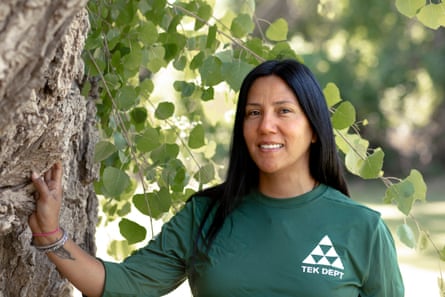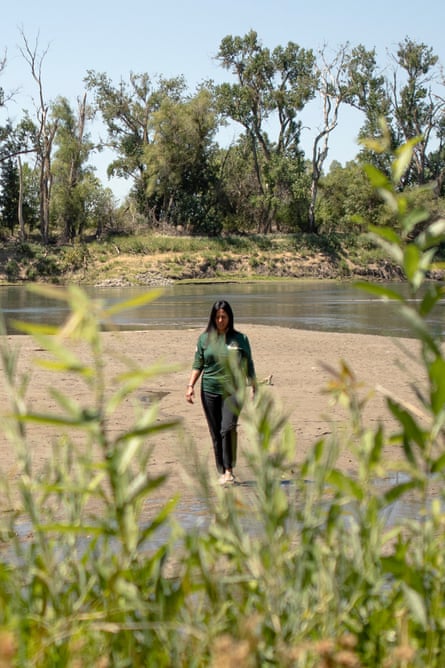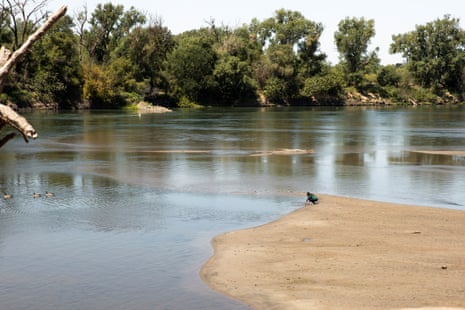In the Bay-Delta, the watershed formed by the two mighty rivers at the heart of California’s water system – the Sacramento and the San Joaquin – signs of worsening climate conditions intensify year after year.
Once abundant species of plants and animals that call these spaces home are disappearing. Flourishing toxic algal blooms threaten the health of the rivers and the people who live near them. As temperatures surge, there’s even less water to go around.
Much of the crisis is caused by climate breakdown, but decades of overuse have made issues worse as larger shares of water are diverted to supply agricultural land and urban consumption. California water authorities have been slow to implement key rules even though they are required by law to review the regulations every three years. Key updates have lagged for decades.
Now, a coalition of Indigenous nations, frontline communities and environmentalists has come together, hoping to spur state water officials to secure not just their water rights but their civil rights. The two, they say, are inextricably tied.
“Everything we need comes from the river,” says Malissa Tayaba, a leader in the Shingle Springs Band of Miwok Indians. “Water is alive. And we can’t live without it.”
‘If the salmon are going extinct, so will we’
Tayaba’s ancestors stewarded these shores for thousands of years before white settlers pushed them from their villages and divvied up the rights to the river resources. In 2021, Tayaba and her tribe were able to repurchase the land, but in recent times, the watershed’s ecosystem has dramatically changed.

Far more water is taken out of the rivers than is sustainable, according to state scientists. Consumers’ water rights in the San Joaquin and Sacramento River basins account for five times the amount of water that actually flows through them. In dry times, between January and June, more than 70% of the water can be diverted from the system.
Meanwhile, roughly 95% of historic wetlands in the delta have been lost, water pollution has caused calamity, and species that once flourished across the 61,000-square-mile watershed are collapsing. Among them, the Chinook salmon are dramatically declining. Known as Nur to the Winnemem Wintu Tribe, they are not only an essential resource but part of the culture.
“We used to be 20,000 people along the river and we’re dwindling out like the salmon,” said Chief Caleen Sisk in a statement following the petition filing. “We only have 126 members of the Tribe left and so if the salmon are going extinct, we can only guess that so will we.”
The only way to slow the devastation, the tribes and environmental groups say, is to enact stricter regulations curbing water use.
In May, the Winnemem Wintu Tribe and the Shingle Springs Band of Miwok Indians along with the environmental groups Save California Salmon, Little Manila Rising and Restore the Delta filed a petition that formally requests the board update its water quality control plan, which regulates how much water must stay in the system.
“What is at stake? Our people literally are at stake because they sit on the land and they are in the ground already,” Tayaba said “You lose your culture. You lose ties to your people – that’s genocide.”

‘Hopelessly out of date’
But creating and enforcing new restrictions is a complicated affair. Powerful California water districts supply drinking water to residents and the rights provide essential hydration to the state’s agricultural industry – which produces over a third of the country’s vegetables and two-thirds of its fruits and nuts.
State leaders have long believed that voluntary agreements and negotiations between the board, water districts and senior rights holders are the best way to avoid years – or even decades – in litigation that stalls progress.
But key stakeholders, including environmental groups, Indigenous nations and fishing industry representatives, have been missing from the agreements. The state’s strategy, advocates say, continues to build on the systemic racism baked into the water rights system itself, which historically barred access to Indigenous peoples and communities of color.
“There couldn’t be a more glaring example of systemic racism than that water rights – the senior ones – could only be planted by white people,” said Jon Rosenfield, a senior scientist at San Francisco Baykeeper. He and his organization have long fought for these regulations and have thrown their weight into the campaign.
Advocates and experts say there’s little time to lose. Although protecting the delta is one of the board’s top responsibilities and state officials have cast it as a priority, the water quality control plan standards have not updated since 1995.
The plan is “hopelessly out of date”, said Richard Frank, professor of environmental practice at the University of California, Davis, School of Law.

Frank, who was appointed by the former governor Arnold Schwarzenegger to serve on a taskforce examining solutions to the delta crisis in 2006, said the regulations were “in dire need of being updated”.
“A lot of climate scientists believe we are lurching into a new normal of severely restricted water availability that makes the ongoing problems of the delta that much more severe and that much more dire,” he said.
‘The threat of cultural genocide’
The board agrees – but still denied the coalition’s petition for immediate action. Edward Ortiz, a board spokesperson, said it had plans to move forward, but at its own speed. The agency expects regulations to be put in place within two years – allowing ample time for negotiations and voluntary agreements recently developed by the California natural resources agency, California department of fish and wildlife, California department of water resources, and public water agencies to be concluded.
These agreements would encourage rights holders responsible for the water diversions to help improve flows and habitat restoration without the need for stringent regulations, state officials argue.
Coalition members see the agreements as a way the board can allow more diversions before the board rules on how much water needs to stay in the system. On Monday, they again requested the board reconsider its timeline.
“The way water is being removed from the system is creating a constellation of harm that most significantly affects frontline communities,” said Sydney Speizman, a student attorney at the Stanford University Environmental Law Clinic, who worked with the coalition to petition the board. On the legal front, she is challenging the board’s right to federal funding for actions that have discriminatory outcomes. “This isn’t a story about agriculture versus fish,” she said, adding that this was in every way a justice story that showcased “all the ways the crisis in the delta poses the threat of cultural genocide”.

‘Not just a California issue’
Adding to the concern is the state’splan to re-engineer the delta, a project expected to add new complications to discussions and regulations. The multibillion-dollar Delta Conveyance, a 45-mile tunnel that would reroute water from the Sacramento River into the delta to supply farms and cities, has been touted by the governor as a strategy to secure the water supply.
A pared-down version of a plan championed by the former governor Jerry Brown and scrapped by Newsom in his first days in office, the new delta tunnel project has still raised ecological concerns, especially because it is being explored ahead of new water quality standards.
In the state’s first report, released late last month, officials note the tunnel could pose more problems for endangered fish, including the delta smelt, winter-run Chinook salmon, and steelhead trout. That means it would also affect the tribes and other frontline communities that depend on them.
Completion of the project would take decades, and significant challenges – along with securing permits and funding – remain.
For 18-year-old Danielle Frank, a Hoopa tribal member and the youth coordinator for Save California Salmon, there’s no time left to waste. The pangs of a rapidly declining delta are felt daily and she’s already been robbed of some aspects of her tribes’ cultural traditions that rely on the declining fish populations and water quality.
“These rivers are drying up because America was founded on genocide and the removal of Native people from their land,” she said. “Issues like these aren’t just California issues, they are happening across the United States. There needs to be a change nationwide – that’s going to be the only way.”
